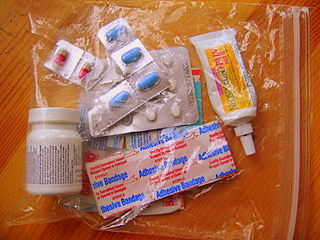 This is what is what I carry when backpacking:
This is what is what I carry when backpacking:
Neosporin. I apply to any wound or infection. Someone told me that if you put some on your urethra you can prevent urinary track infections.
Bandaids Most blisters, I pop with a needle, put some Neosporin on them, and cover with a bandaid. Some bandaids work better than others. If your bandaid keeps falling off you can duct tape it on. In the beginning of a long hike you may need lots of blister stuff. After I have been on the trail for awhile, I don’t get blisters very often. Second Skin is also good for blisters. It’s sort of heavy but in the beginning of your hike it may be worth carrying.
Pain relievers, -Ibuprofen is my personal favorite though I often bring a variety. Don’t rely on aspirin as a your main pain reliever as it increases bleeding and puts you at and risk in the event of an accident for excessive blood lost. Some people in addition carry some heavy duty prescription pain medications, like Oxycontin/Oxycodine, or morphine in case of a break or sprain. A good idea if you can get them.
Aspirin– just a little, good for your heart. Don’t take too much as it will increase bleeding in the event of injury.
Benedryl– not only good for allergies but also good if you are having trouble sleeping. -not just good for airborne allergic reactions but also plant and insect bite reactions.
Claritain. Good for allergies when you don’t want to be sleepy.
Decongestants– also good if you need to stay awake to hike out in an emergency. These are sold without a prescription but apparently you have to ask for them, now.
Emer’gen-C good for replacing electrolytes in the event of dehydration. At an advanced wilderness first aid course, the instructor said that heavy doses of Vitamin C can prevent and even cure urinary track infections by making your urine so acid that nothing can live in it.
Tums or some kind of antacid. Sometimes trail food can cause acid indigestion and make for a really horrible night.
I carry a needle in my dental floss case to pop blisters. I carry duct tape wrapped around one of my water bottles, not just for repairs, but also for taping a splint made from my pad on if I needed to. Every thing is kept in a plastic ziplock.
On my last hiking trip, I pulled a thigh muscle and a hiker I meet gave me her ace bandage. Later in my hike, I met a woman with a sore knee and I passed it on to her. I’m thinking of starting to bring an ace bandage with me. It does offer some relief.
Carrying spare items especially pain killers is a good idea, for when you run into other less prepared people. Well done to the woman who gave you the ace bandage and well done for passing it on.
I’d second carrying both ibuprofen and aspirin: ibuprofen since it’s such a great pain reliever/anti-inflammatory (max 800 mg three times a day for a typical 70 kg adult), and aspirin in case you run into a middle-aged+ person complaining of substernal pain: aspirin is a first line drug in a suspected MI, but it is a potent anti-platelet agent.
One other suggestion: you might want to carry Steri-strips, or some equivalent. You can get them in most drug stores and they work great for closing up largish cuts that a single bandaid might not adequately cover. Just be sure to clean the cut well before applying the strips.
Lastly, have your doctor give you a tetanus booster before leaving on an extended hike. It’s simple insurance against a very bad disease.
Wow. You have excellent idea. It is important to have those things with you especially when are go for travel, climbing, camping, sports activity or even at home. And thanks for the tips its a big help. This is good. Keep it up.